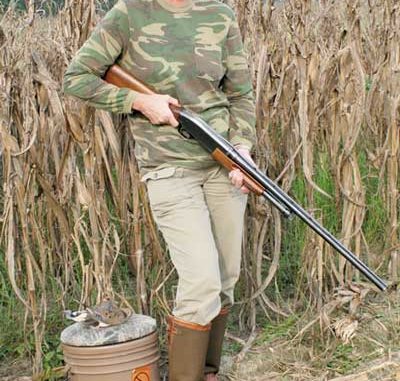
SCDNR fields bring dove-hunting opportunities to the public.
“Mark!”
“Bird!”
“There comes a bird, behind you.”
“Low bird, low bird, don’t shoot!”
“Down the middle, high bird — nice shot!”
The sounds of a dove shoot stir memories. Everyone remembers their first one.
Some of us were lucky to attend a private shoot, one where socially-connected sportsmen gathered with their fancy shotguns and afterwards talked politics and told tall tales while sipping on an adult beverage.
My first shoot was in the 1960s, one of those private affairs where the town fathers in Fayetteville, N.C., brought soldiers from Fort Bragg to a dove shoot and oyster roast. A late-season event taking place in December, the shoot was something to which any knowledgeable dove enthusiast would love an invitation.
I was not one of those knowledgeable hunters. Rather, I was a young second lieutenant in the U.S. Army, fresh from college and newly married, doing my duty rather than dodging the Viet Nam draft. But getting that invitation still amazes me to this day.
When I reported to Fort Bragg in May, assigned to help re-establish a basic training center, the only people on station were the commanding general (still a bird colonel at that time) and the sergeant major. After checking in with the sergeant major, I was told to settle into quarters and report for officers’ call the next Friday. Officers’ call in those days was happy hour.
Only a half dozen or so showed up that Friday and, being naive enough not to know any better, I sat down with the colonel, and we talked about hunting for the whole hour.
Fast forward to November. I received a message to report to the sergeant major. I didn’t think I’d screwed up, so I promptly reported as requested.
“Lt. Gribb,” the sergeant major said, “The general received two invitations to the annual Fayetteville/Fort Bragg dove shoot and oyster roast. He told me to give one to an NCO of my choice and one to you.”
Pretty unbelievable!
The shoot is on
I showed up at the shoot in fatigues, carrying my only shotgun, a youth model H&R Topper, 20-gauge, with a full choke, 28-inch barrel and a homemade, 2-inch stock extension, crosscut from a chunk of maple and screwed on between the butt and the recoil pad.
Fortunately, the other hunters were well mannered enough not to laugh. As anyone would imagine, I missed the first dozen shots or so. Those birds were quick and didn’t fly in a straight line like our homegrown pheasants. After a while, I caught up with them, managing to knock down three or four in a row near the end of the day, bringing the total to a respectable seven birds. That old gun still gets called into action on occasion, just for old times’ sake.
Public hunts
Frankly, most of us aren’t invited to fancy private shoots, and even if we get an occasional treat, we still want to shoot doves more than a couple of times a year. Sharing the excitement of Opening Day in a dove field with 100 or so of our “closest friends” is our best option. We attend public shoots.
But that’s not bad, especially in South Carolina, where public fields are beautifully prepared and managed by professional biologists and their staff. The S.C. Department of Natural Resources (SCDNR) sponsors safe and popular hunts at dozens of fields, where hunters harvest tons of birds. Making the most of these opportunities requires timing, planning and a little luck.
Start your homework at the SCDNR website (www.scdnr.gov) and look for public dove fields. Updated information for the 2008 season is available in late July. Start with fields in your general area, within a 2-hour drive, and then begin researching the specifics.
To be most effective, you need the real skinny, so make an on-site visit before the season. August is a good time since the attracting crops, often sunflowers and wheat, are ripe, and the SCDNR staff is beginning to manipulate them for maximum bird holding. Later, during the actual hunting season, phoning a Wildlife Management Area (WMA) office will get you an assessment of their current conditions.
South Carolina staggers the “opening days” on WMAs, reserving several for youth-only hunts and spacing the rest throughout the opening week to allow maximum participation. This affords those who have to work on opening Saturday a chance at a fresh field and also those with flexible schedules to hunt frequently. During the remaining season, most WMA dove shoots are limited to specific days.
According to Billy Dukes, small-game project supervisor for SCDNR, last year was a bit below normal, with an average of 3.05 doves per hunter harvested in the 38 fields they monitored on Opening Day.
“Any harvest above 4.0 doves per hunter is very good,” Dukes said, making last year’s reduced production still pretty good.
Some 3,170 hunters participated on monitored hunts, representing an increase of 18 percent. Of the 50 public fields, the most productive were Evans in Anderson County, Thurman in Union County, Crackerneck WMA in Aiken County, Draper in York County and Gaffney Public Works in Cherokee County, all of which averaged about six to eight birds per hunter.
Kids’ shoots
A major focus at SCDNR is introducing youngsters to hunting, so they give high priority to youth dove hunts, reserving some of the finest fields for youth-only opening days. The goal is to give children a great experience they will remember forever.
With gun-sport introductions, it’s hard to get predictable action, but a good dove field is an exception. Many parents grab an extra stool, some snacks and drinks, and let their youngsters tag along to experience the sights and sounds of hunting. The gathering of gear and guns, the dressing in camouflage clothing and the massing of hunters prior to the opening hour sets the stage.
Willie Simmons, a wildlife biologists headquartered in Columbia, works with the Sumter youth hunt on the Manchester State Forest. He said that because the SCDNR picks quality fields, the conditions and bird counts will be either good or excellent, depending on the weather.
All are draw hunts on fairly small fields, with limited spots available, except for Orangeburg. Some allow reservations by phone, and others have a drawing for available spots. Details are at the end of the public dove field list on the SCDNR website.
On Simmons’ field, the event unfolded in a typical fashion, with about 30 youth hunters selected. After everyone was assembled, a wildlife biologist and an environmental officer covered the rules of the hunt and gun safety. After that briefing, groups move to spots in the field that allow safe margins between shooters.
The rules allow two, but most parents bring only one child. Simmons estimated that 10 to 20 percent of the participants have children ages five to nine who are absorbing the experience of the hunt by watching there father or mother shoot, eating snacks, drinking soda and making retrieves. The rest are either in that transition period where they shoot at a few birds and retrieve some birds shot by adults or are older kids who do most of the shooting themselves. Adults may actively participate in the hunt, but they may not shoot while their accompanied youth is shooting.
The SCDNR is investing in the future of hunting by putting its money where its mouth is, and there aren’t many people — even the rich and famous — who could provide better conditions for a youngster’s initiation to a true southern tradition.
First-class dove shoots
The SCDNR holds many more dove shoots on their WMAs and other public-access fields, and they do it right. Of course, they have an advantage over most small landowners. They have lots of land, and they allocate adequate money — even from their stretched budgets — to one of their most-popular and well-attended shooting venues.
The public dove fields are planted and manipulated to encourage doves to visit and stay around. The preparation almost seems like cheating, but guidelines and game laws that strictly describe what is legal and what is not are followed.
Most doves are hunted over one of three kinds of fields: harvested fields where normal fall crops such as corn and soybeans have been combined and the residual grain has attracted doves; manipulated fields where crops were grown for the purpose of attracting wildlife; and freshly-planted fields.
Unlike farmers, the SCDNR’s only crop for harvest is birds, which means their farming only supports the breeding and feeding of wildlife.
Along with his staff, Dean Harrigal, the chief biologist in charge of Donnelley and Bear Island WMAs in the Lowcountry between Charleston and Beaufort, works the land to attract and hold deer, turkey, ducks and other small game and non-game species, in addition to the doves.
“Doves are not cheap,” Harrigal said repeatedly. “Doves used to be easy; every farm had them, and the deer were scarce.”
That is no longer the case. Doves are still prolific breeders, but in areas where deer are thick, fencing dove fields is required to keep deer from eating the grain. Most WMA fields in South Carolina are electric-fenced.
WMA fields are normally planted in alternating strips of wheat, sunflower and corn to provide food and cover throughout the season. The first planting, for the next year’s birds, begins before the current season even ends with an October or November drilling of winter wheat. Doves are ground feeders, so standing crops do them no good until the seeds fall. Birds also need a water source and tilled soil for their crops.
Wheat is the early key
Arguably the most important crop, and one that is missing from many private fields, is the fall planting of winter wheat — a bearded variety to discourage deer browsing.
Because the season is still open, wheat seeds must be planted using normal agricultural practices, meaning that the soil must be freshly plowed or disced and the seeds drilled or covered with an inch of soil. Broadcasting seeds onto the surface is considered baiting. This fall planting of wheat matures the next summer and forms the foundation for successful early season dove shoots.
The SCDNR’s goal is to stage a massively successful opening-day hunt in each field they sponsor. The goal is to attract every dove within a 10-mile radius during August and keep them coming back until their “opening day.” Wheat starts the process.
By July, when corn is growing rapidly and sunflowers are maturing, the wheat has fully matured, turned brown and is falling over. The first step of the “harvest” is an application of weed killer to the area if the weeds are still green and strong. When everything turns brown, DNR staff begins mowing portions of the wheat strips to spread the seeds. It doesn’t take long for the word to get around among the dove population that easy food is available.
The next most-important crops used by the SCDNR are sunflowers planted in mid-April to late May. The small-seeded, black-oil variety is used because it makes more seeds and is heartier than the large-seed flowers. Sunflowers also mature before the season and act as the transition from wheat, serving as the main attractant during the early season. If given a choice on an early-season hunt, set up overlooking the sunflowers.
Damage to sunflowers from browsing deer is almost certain if deer are plentiful. As Harrigal said, “Deer damage everything we plant, and sunflowers are the biggest attractant”
The third crop in the rotation is corn. The large-kernelled, yellow cattle corn is planted is mid-March to April, to mature just as the season begins. In the early season, standing corn is used as much as hunter blinds as it is for a food source, but later, as other crops are consumed, it becomes both blind and food. It is knocked down or “harvested” in stages as the season progresses.
Crops areas that get over-browsed, damaged or fail due to weather and other reasons are often replanted with brown top millet or dove proso millet, which are hearty, rapidly-maturing and not very attractive to deer. Benne sesame is also used at times.
Opening day
By the time Opening Day arrives, the wheat strips are gone, most seeds eaten and the area disced to expose soil and any remaining seeds. When hunters arrive, they see freshly-cultivated soil where wheat once stood, sunflower strips that are mostly falling over and partially eaten by the birds, and strips of corn that are ripe and upright, providing ideal hiding places.
The easy availability of food has done its job. Local birds have discovered the area and come back every afternoon. The crop maturation and harvest progression has hunters aiming at the plentiful birds flying unexpectedly into their dining area. Scores of hunters surround every WMA field and shoot thousands of shot shells at the darting doves.
How good are the September opening hunts? At two hunts we recently attended, about 130 people shot about 600 birds in one field, and in the other, 140 hunters shot about 500 birds. Those are impressive numbers, rarely matched by even the best private hunts.
In public fields, opening-day hunts account for 90 percent of the birds taken. When it’s all over, good shooters have filled their bag limits, and the rest of us have at least made a lot of noise and have a few doves home for the broiler.
It doesn’t get a lot better than this — except maybe at a traditional southern, private dove shoot.

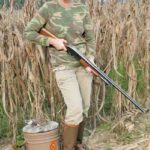
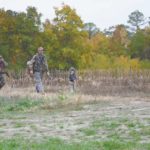
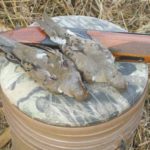
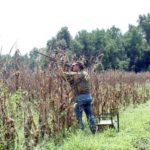
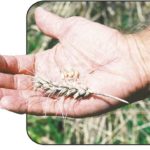


Be the first to comment